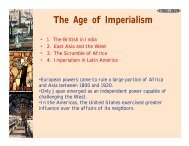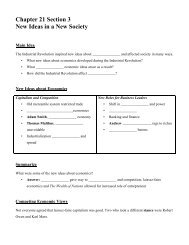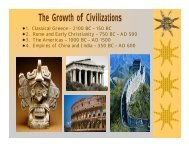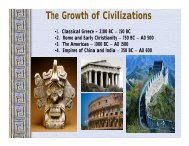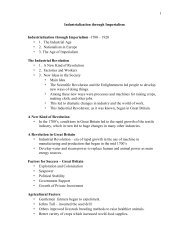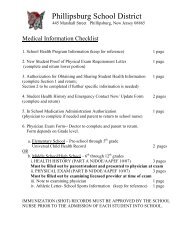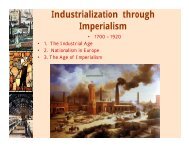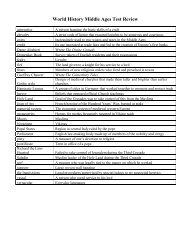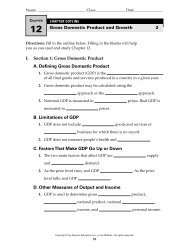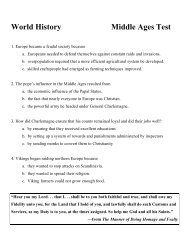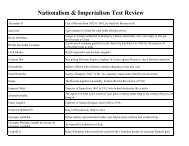Ancient India and China
Ancient India and China
Ancient India and China
You also want an ePaper? Increase the reach of your titles
YUMPU automatically turns print PDFs into web optimized ePapers that Google loves.
The Dawn of Civilization<br />
• Prehistory to AD 300<br />
•1. The Beginnings of Civilization – Prehistory to 1000 BC<br />
•2. The <strong>Ancient</strong> Near East – 4000 BC – 550 BC<br />
•3. The Nile Civilizations – 5000 BC – AD 300<br />
•4. <strong>Ancient</strong> <strong>India</strong> <strong>and</strong> <strong>China</strong> 2500 BC – 250 BC
<strong>Ancient</strong> <strong>India</strong> <strong>and</strong> <strong>China</strong><br />
2500 BC – 250 BC<br />
•1. Early <strong>India</strong><br />
•2. Hinduism<br />
•3. Buddhism<br />
•4. <strong>China</strong>’s First Dynasties<br />
•Like Mesopotamia <strong>and</strong> Egypt, <strong>India</strong> <strong>and</strong> <strong>China</strong> were each<br />
home to an early river civilization<br />
•They developed their own governments, languages,<br />
customs, <strong>and</strong> social structures<br />
•Religions <strong>and</strong> philosophies helped shape the lives of people<br />
in Asia
1. Early Civilizations of <strong>Ancient</strong><br />
<strong>India</strong><br />
2500-250 BC<br />
•Early civilization arose in the Indus River Valley, flourished,<br />
<strong>and</strong> then mysteriously died out<br />
•Later, <strong>India</strong>’s Vedic civilization developed a culture based on<br />
old <strong>and</strong> new beliefs (Hinduism)
2500 – 250 BC<br />
Indus River Civilizations<br />
•Indus River Valley<br />
•Subcontinent-large l<strong>and</strong>mass that is part of a continent<br />
•first two Indus River Civilizations were the Harappan <strong>and</strong> Mohenjo-Daro -<br />
Mound of the Dead
Wide View, Mohenjo-Daro<br />
2500 – 250 BC<br />
•The first ruins of the Indus River Valley<br />
•Within these ruins, archaeologists found hundreds of<br />
artifacts, including statues, that can help us learn more<br />
about ancient <strong>India</strong>n life
2500 – 250 BC<br />
Aerial View of Mohenjo-Daro<br />
•Mohenjo-daro was well planned <strong>and</strong> carefully laid out<br />
•Streets ran in grid pattern, north-south, east-west
2500 – 250 BC<br />
Citadel (Fortress) Of Mohenjo-Daro<br />
•In the largest cities, a walled,<br />
elevated citadel, or fortress,<br />
enclosed buildings such as<br />
granaries, warehouses, <strong>and</strong><br />
meeting halls<br />
•Homes, workshops, <strong>and</strong> shrines<br />
were built outside the citadel<br />
•Such planning suggests a<br />
central authority held the<br />
power
Well, Mohenjo-Daro<br />
2500 – 250 BC<br />
•people drew water from community<br />
wells<br />
•Or drew water from smaller wells dug<br />
in the courtyards of their homes
Drain, Harappa<br />
2500 – 250 BC<br />
•Public drainage systems carried away wastewater
2500 – 250 BC<br />
A Main Street, Mohenjo-Daro<br />
•Streets ran in<br />
grid pattern,<br />
north-south, eastwest<br />
•Major avenues<br />
that were twice as<br />
wide as minor<br />
streets
Granery, Mohenjo-Daro<br />
2500 – 250 BC<br />
•Economy was based on agriculture <strong>and</strong> trade<br />
•Most people farmed <strong>and</strong> herded livestock
2500 – 250 BC<br />
The Great Bath, Mohenjo-Daro
Harappan Writing<br />
2500 – 250 BC<br />
•More than 3,000 samples of Indus script have been found, including<br />
many seals that depict realistic animals alongside the writing
Indus Civilization Seals<br />
2500 – 250 BC<br />
Bison Seal, mohenjo daro<br />
Unicorn Seal,<br />
Harappa<br />
Horned-God Seal,<br />
mohenjo daro<br />
•Despite the best efforts of the archaeologists <strong>and</strong> linguists,<br />
however, no one has yet been able to decipher even one word from<br />
any of the seals
2500 – 250 BC<br />
A Male Head, Mohenjo-Daro<br />
•Dravidian-originators of Indus River Civilization
Male Skeleton, Harappa<br />
2500 – 250 BC
Female Skeleton with Child,<br />
Harappa<br />
2500 – 250 BC
•Sometime after 2000 BC, a new people took control of<br />
<strong>India</strong>.<br />
•Aryans – “noble”<br />
•Historians disagree where they came from (either Indo-<br />
European or originated there)<br />
2500 – 250 BC
Aryan (noble) Migration<br />
2500 – 250 BC<br />
•Took control of the Harappan civilization<br />
• pastoral depended on their cattle.<br />
• warriors horse-drawn chariots.
Sanskrit<br />
2500 – 250 BC<br />
•ancient <strong>India</strong>n writing <strong>and</strong> the<br />
classical language<br />
•Means “refined <strong>and</strong> sanctified”
The Vedas<br />
2500 – 250 BC<br />
• 1200 BCE-600 BCE.<br />
• written in SANSKRIT.<br />
• Hindu core of<br />
beliefs:<br />
‣ hymns <strong>and</strong> poems.<br />
‣ religious prayers.<br />
‣ magical spells.<br />
‣ lists of the gods<br />
<strong>and</strong> goddesses.<br />
Rig Veda oldest work.
Varna (Social Hierarchy)<br />
2500 – 250 BC<br />
Priests <strong>and</strong> teachers<br />
Brahmins<br />
‣Rigveda – Vedic<br />
society divided into<br />
four social classes<br />
Warriors <strong>and</strong> Rulers<br />
Kshatriyas<br />
Traders, farmers,<br />
herders<br />
Vaishyas<br />
Servants<br />
Shudras<br />
Pariahs [Harijan] Untouchables
Caste System<br />
2500 – 250 BC<br />
WHO IS…<br />
Brahmins<br />
• The mouth?<br />
• The arms?<br />
• The legs?<br />
• The feet?<br />
Kshatriyas<br />
Vaishyas<br />
What is a JATI?<br />
People under their feet or<br />
rule<br />
Shudras
Religions of South Asia<br />
2500 – 250 BC<br />
•Hinduism gave birth<br />
to Buddhism, Jainism,<br />
Sikhism<br />
•Christianity –Jesus<br />
Christ, son of God –<br />
the Bible<br />
•Islam – Muhammadlast<br />
prophet to talk to<br />
Allah – t he Quran<br />
•Do you think Islam<br />
had an effect on<br />
Hindu <strong>India</strong>?
2500 – 250 BC<br />
2. Hinduism?<br />
• The religion of Hinduism developed <strong>and</strong> evolved over a long time in<br />
<strong>India</strong>, giving rise to a variety of beliefs <strong>and</strong> practices <strong>and</strong> to other<br />
religions, including Jainism
2500 – 250 BC<br />
What is Hinduism?<br />
• One of the oldest religions of humanity<br />
• The religion of the <strong>India</strong>n people<br />
• Its origins are difficult to trace<br />
Brahman
2500 – 250 BC<br />
How did Hinduism begin?<br />
• No particular founder<br />
• Indus River Valley Civilization >5000 years ago<br />
• Aryans enter 4000 - 3500 years ago<br />
• Vedic Tradition 3500 – 2500 years ago:
2500 – 250 BC<br />
What do Hindus believe?<br />
• One impersonal Ultimate Reality – Brahman -the<br />
creator<br />
• Atman, the soul, is Brahman trapped in matter<br />
• Reincarnation – reborn into this world lifetime<br />
after lifetime (Samsara)<br />
• Karma – spiritual impurity due to actions keeps<br />
us bound to this world (good <strong>and</strong> bad)
2500 – 250 BC<br />
How does Hinduism direct<br />
life in this world?<br />
– Dharma-set of spiritual duties-based on class <strong>and</strong> station<br />
– Four “stations” of life (Caste) - priests & teachers, nobles &<br />
warriors, merchant class, servant class<br />
– Four stages of life – student, householder, retired, renunciant
2500 – 250 BC<br />
What are the Sacred Texts?<br />
• Shruti (“heard”) – oldest, most<br />
authoritative:<br />
– Four Vedas (“truth”) – myths, rituals,<br />
chants<br />
– Upanishads - metaphysical<br />
speculation<br />
• Smriti (“remembered”) – the Great<br />
<strong>India</strong>n Epics:<br />
– Ramayana<br />
– Mahabharata (includes Bhagavad-<br />
Gita)
2500 – 250 BC<br />
What are the spiritual<br />
practices of Hinduism?<br />
• Yoga-meditation in order to attain moksha<br />
• Ultimate goal of life – to release Atman <strong>and</strong> reunite with the divine,<br />
becoming as one with Brahman (Moksha)
Who do Hindus worship? –<br />
2500 – 250 BC<br />
the major gods of the Hindu Pantheon<br />
Brahma, the creator god
Who do Hindus worship? –<br />
2500 – 250 BC<br />
the major gods of the Hindu Pantheon<br />
Vishnu, the preserver god<br />
Incarnates as ten avatars (descents) including:<br />
Rama (featured in the Ramayana)<br />
Krishna (featured in the Mahabharata)<br />
(Each shown with his consort, Sita <strong>and</strong> Radha, respectively)
Who do Hindus worship? –<br />
2500 – 250 BC<br />
the major gods of the Hindu Pantheon<br />
Shiva, god of constructive destruction (the transformer)<br />
Appears as Shiva Nataraj,<br />
lord of the dance of creation…<br />
<strong>and</strong> with his wife, Parvati, <strong>and</strong> son Ganesha<br />
(the elephant headed remover of obstacles)
What about the goddesses?<br />
Devi – the feminine divine<br />
2500 – 250 BC<br />
•Saraswati, goddess of wisdom, consort of Brahma
2500 – 250 BC<br />
What about the goddesses?<br />
Devi – the feminine divine<br />
Lakshmi, goddess of good fortune, consort of Vishnu
2500 – 250 BC<br />
What about the goddesses?<br />
Devi – the feminine divine<br />
•Parvati, divine mother, wife of Shiva
2500 – 250 BC<br />
What about the goddesses?<br />
Devi – the feminine divine<br />
Durga, protectress<br />
Plus about 330 million other deities<br />
Kali, destroyer of demons
All these deities are but<br />
Manifest forms (attributes<br />
<strong>and</strong> functions) of the<br />
impersonal Brahman
Jainism<br />
2500 – 250 BC<br />
•500 BC – a group of Hindus broke away<br />
•Mahavira – Jainism – thought Hindus placed too much<br />
emphasis on ritual<br />
Plus about 330 million other deities<br />
•Ahimsa- nonviolence towards living things; avoid stealing<br />
<strong>and</strong> tell the truth
2500 – 250 BC<br />
3. Buddhism<br />
•Buddhism, which<br />
teaches people that<br />
they can escape the<br />
suffering of the world<br />
through the Buddhist<br />
teachings, developed in<br />
<strong>India</strong> <strong>and</strong> spread to<br />
other parts of Asia
2500 – 250 BC<br />
Siddhartha Gautama (563-483 BCE)<br />
<br />
<br />
<br />
<br />
Unlike Hinduism,<br />
Buddhism can be<br />
traced to one single<br />
founder, Siddhartha<br />
Gautama<br />
Prince of a small<br />
kingdom; he lived<br />
sheltered life <strong>and</strong><br />
sought the answer to<br />
ending suffering<br />
After years of<br />
meditation searching<br />
for Nirvava he<br />
became Enlightened<br />
He transformed into<br />
Buddha
What is the fundamental cause of<br />
all suffering?<br />
2500 – 250 BC<br />
Desire!<br />
<br />
Therefore, extinguish the self, don’t obsess about<br />
oneself. Give up all materials <strong>and</strong> possessions of the<br />
world.
2500 – 250 BC<br />
Four Noble Truths<br />
‣ There is suffering in the world. To live is to suffer.<br />
(Dukkha)<br />
‣ The cause of suffering is self-centered desire <strong>and</strong><br />
attachments. (Tanha)<br />
‣ The solution is to eliminate desire <strong>and</strong> attachments.<br />
(Nirvana = “extinction”)<br />
‣ To reach nirvana, one must follow the Eightfold Path.
Eightfold Path<br />
2500 – 250 BC<br />
Right Underst<strong>and</strong>ing<br />
Right Intention<br />
Right Speech<br />
Right Action<br />
Right Livelihood<br />
Right Effort<br />
Right Concentration<br />
Right Mindfulness
2500 – 250 BC<br />
Eightfold Path<br />
Nirvana<br />
The union with the ultimate spiritual reality.<br />
Escape from the cycle of rebirth. Reincarnation
2500 – 250 BC<br />
Types of Buddhism<br />
<br />
<br />
<br />
<br />
Therevada<br />
Buddhism<br />
Mahayana<br />
Buddhism<br />
Tibetan<br />
Buddhism<br />
Zen<br />
Buddhism
2500 – 250 BC<br />
Theravada Buddhism<br />
<br />
<br />
<br />
<br />
<br />
<br />
<br />
The oldest school of Buddhism.<br />
The “Way of the Elders” or the “Small Vehicle.”<br />
Found in southern Asia.<br />
The monastic life is the best way<br />
to achieve nirvana.<br />
Focus on wisdom <strong>and</strong> meditation.<br />
Goal is to become a “Buddha,” or “Enlightened One.”<br />
Over 100,000,000 followers today.
2500 – 250 BC<br />
Mahayana Buddhism<br />
<br />
<br />
<br />
<br />
<br />
The “Great Vehicle.”<br />
Founded in northern Asia (<strong>China</strong>, Japan).<br />
Buddhism “for the masses.”<br />
Seek guidance from Boddhisatvas, wise beings.<br />
Goal: Not just individual escape from the wheel, but<br />
the salvation of all humanity through self-sacrifice of<br />
those enlightened few.
2500 – 250 BC<br />
Tibetan Buddhism<br />
The “Diamond Vehicle.” [Vajrayana]<br />
Developed in Tibet in the 7c CE.<br />
A mix of Theravada <strong>and</strong> Mahayana.<br />
Boddhisatvas include Lamas, like<br />
the Dalai Lama.<br />
The Tibetan Book of the Dead<br />
[Bardo Thodol].
The Dalai Lama<br />
2500 – 250 BC
2500 – 250 BC<br />
Zen Buddhism<br />
The “Meditation School.”<br />
Seeks sudden enlightenment [satori] through meditation, arriving at<br />
emptiness [sunyata].<br />
Use of meditation masters [Roshi].<br />
Beauty, art, <strong>and</strong> aesthetics:<br />
• Gardens.<br />
• Archery.<br />
• Tea ceremony.<br />
• Calligraphy.
Buddhism in America (1999)<br />
2500 – 250 BC
Relieve Stress & Meditate:<br />
Get a Mantra !<br />
2500 – 250 BC<br />
Ohm...mani...padme...hung...<br />
Hail to the jewel in the lotus!
4. <strong>China</strong>’s First Dynasties<br />
2500 – 250 BC<br />
2500-250 BC<br />
•<strong>China</strong>’s river valley civilizations built the foundations of a long shared<br />
Chinese culture.<br />
•The achievements of the Shang <strong>and</strong> Zhou dynasties can be felt to this<br />
day.
Neolithic <strong>China</strong><br />
2500 – 250 BC<br />
Sinanthropus<br />
pekinesis<br />
•“Peking Man”<br />
(750,000 – 500,000 BCE)<br />
•<strong>China</strong>’s isolation helped early<br />
civilization develop <strong>and</strong> grow<br />
without foreign intrusion for<br />
several centuries.
Yellow River Civilization<br />
2500 – 250 BC<br />
•<strong>China</strong> first civilizations, like <strong>India</strong>, Egypt, <strong>and</strong> the Middle East<br />
began around fertile river valleys.<br />
•Chang Jiang <strong>and</strong> Huang He (Yellow River) – annual floods<br />
•Loess-fine dusty soil that was carried into <strong>China</strong> by desert winds
Pan-Gu<br />
2500 – 250 BC<br />
•Mythical Creator of the Universe
Yu, the Great<br />
2500 – 250 BC<br />
•Founder of the Asia
“Huangdi” – Emperor<br />
2500 – 250 BC<br />
• The “Yellow Emperor.”<br />
• Legend has it that he ruled for<br />
over 100 years.<br />
• Associated with the invention of<br />
wheeled vehicles, ships
2500 – 250 BC<br />
Emperor Fuxi<br />
• Mythical Asia ruler.<br />
• Taught the Chinese how to read<br />
<strong>and</strong> write, according to legend.
The Shang Dynasty<br />
2500 – 250 BC<br />
•Most historians date the beginning of early Chinese civilization to the<br />
rise of the Shang Dynasty.<br />
•According to legend formed around 1766 BC <strong>and</strong> centered around the<br />
Yellow River valley. During the Bronze Age
Religious Beliefs<br />
2500 – 250 BC<br />
•Much of what historians know about the Shang, comes<br />
from studying royal tombs.<br />
•Shang religion centered around ancestor worship.<br />
•Oracle Bones -bits of animal bones used to advise Shang<br />
•Part of their worship
The Evolution of Chinese Writing<br />
2500 – 250 BC<br />
•Pictographs – the<br />
development of writing tied<br />
into the oracle bones<br />
•Symbols actually written on<br />
the bones to represent<br />
objects or ideas<br />
•Semantic-Phonetics –<br />
eventually replaced<br />
Chinese pictographs
Oracle Bones Calendar<br />
2500 – 250 BC<br />
•Shang astronomers created precise calendars based on the<br />
cycles of the moon.<br />
•They may have created one of the first systems of money.
Axe Scepter 1100 BCE - jade<br />
2500 – 250 BC<br />
Ceremonial Dagger 1028 BCE
Shang Urn<br />
2500 – 250 BC
Shang Bronzes<br />
2500 – 250 BC<br />
•Major advances in bronze making<br />
•Artists created highly decorated bronze vessels <strong>and</strong><br />
objects – used in religious rituals
The Zhou Dynasty<br />
2500 – 250 BC<br />
•The Shang ruled <strong>China</strong> for more than 600 years, but<br />
in 1100 BC, armies from a nearby tribe called the Zhou<br />
invaded <strong>and</strong> established a new ruling dynasty.
Western Zhou: 1027-771 BCE<br />
2500 – 250 BC<br />
•The Zhou held power for<br />
several centuries<br />
•Divided into two periods<br />
•Western Zhou - Xian<br />
•Eastern Zhou - Luoyang
Eastern Zhou: 771-256 BCE<br />
2500 – 250 BC<br />
•During the reign of the<br />
first period, the dynasty<br />
experienced peace.<br />
•Later, however, conflict<br />
arose in <strong>China</strong> <strong>and</strong> the kings<br />
moved east.<br />
•When the Zhou conquered<br />
the Shang, their leaders<br />
worried that the Chinese<br />
would not accept them.<br />
•To gain acceptance, they<br />
introduced the M<strong>and</strong>ate of<br />
Heaven.
The M<strong>and</strong>ate of Heaven<br />
2500 – 250 BC<br />
“T’ien Ming”<br />
1. The leader must lead by ability <strong>and</strong> virtue.<br />
2. The dynasty's leadership must be justified by<br />
succeeding generations.<br />
3. The m<strong>and</strong>ate could be revoked by negligence <strong>and</strong><br />
abuse; the will of the people was important.
•The rise <strong>and</strong> fall of<br />
dynasties in <strong>China</strong> – any<br />
Start here<br />
power that lost power<br />
was because they lost<br />
their m<strong>and</strong>ate<br />
A new<br />
dynasty<br />
comes to power.<br />
The emperor<br />
reforms the govt.<br />
& makes it more<br />
efficient.<br />
2500 – 250 BC<br />
Emperor is<br />
defeated !!<br />
Rebel b<strong>and</strong>s find<br />
strong leader who<br />
unites them.<br />
Attack the emperor.<br />
Poor lose<br />
respect for govt.<br />
They join rebels<br />
& attack l<strong>and</strong>lords.<br />
The<br />
Dynastic<br />
Cycle<br />
Lives of common<br />
people improved;<br />
taxes reduced;<br />
farming encouraged.<br />
Problems begin<br />
(extensive wars,<br />
invasions, etc.)<br />
Taxes increase;<br />
men forced to<br />
work for army.<br />
Farming neglected.<br />
Droughts,<br />
floods,<br />
famines occur.<br />
Govt. increases<br />
spending;<br />
corruption.
Zhou Achievements<br />
2500 – 250 BC<br />
• Pendant of a Dancer - jade<br />
3c BCE (Eastern Zhou)<br />
Ritual Food Vessel,<br />
bronze 11c BCE (Western<br />
Zhou)<br />
•The Zhou learned how<br />
to use iron, which<br />
replace the Bronze Age.<br />
•This strengthened<br />
their empire – catapult<br />
<strong>and</strong> the first cavalry<br />
•Better farming<br />
techniques, roads <strong>and</strong><br />
canals, transportation<br />
<strong>and</strong> communication
Decline of the Zhou<br />
2500 – 250 BC<br />
•Warring States Period – 403 BC – 221 BC – a<br />
number of small states headed by nobles fought for<br />
l<strong>and</strong> <strong>and</strong> power over the king<br />
•Eventually, the Qin dynasty rose to power <strong>and</strong><br />
ended the reign of the Zhou Dynasty.
Major Chinese Philosophies<br />
2500 – 250 BC<br />
•Conflicts during the Warring States Period allowed<br />
many Chinese thinkers to question the nature of society<br />
<strong>and</strong> of people’s roles in it.<br />
•Confucianism – treat one another humanely to improve<br />
society – Kongfuzi<br />
•Daoism – retreat from the laws of society <strong>and</strong> yield to<br />
the laws of nature<br />
•Legalism – the law is the supreme authority – rule with a<br />
firm h<strong>and</strong>
2500 – 250 BC<br />
Confucius<br />
* 551 – 479 B.C.E.<br />
* Born in the feudal state of<br />
Liu.<br />
* Became a teacher <strong>and</strong> editor<br />
of books.<br />
*Express love <strong>and</strong> respect for<br />
one another by practicing<br />
traditional manners
2500 – 250 BC<br />
Major Confucius Principles<br />
Li --> Rite, rules, ritual decorum (Binding force of an<br />
enduring stable society)<br />
Ren --> humaneness, benevolence, humanity<br />
Shu --> Reciprocity, empathy<br />
Do not do unto others what you would<br />
not want others to do unto you.<br />
Yi --> Righteousness<br />
Xiao --> Filial Piety (Respect your elders!)
Five Principle Relationships<br />
2500 – 250 BC<br />
1. Ruler Subject<br />
2. Father Son<br />
3. Husb<strong>and</strong> Wife<br />
4. Older<br />
Brother<br />
5. Older<br />
Friend<br />
Younger<br />
Brother<br />
Younger<br />
Friend
Confucian Temple<br />
2500 – 250 BC
2500 – 250 BC<br />
The Analects<br />
* The single most important Confucian work.<br />
* In Chinese, it means “conversation.”<br />
* Focus on practicalities of interpersonal relationships <strong>and</strong><br />
the relationship of the role of rulers <strong>and</strong> ministers to the<br />
conduct of government.
2500 – 250 BC<br />
Saying from The Analects<br />
* Knowing what he knows <strong>and</strong> knowing what he<br />
doesn’t know, is characteristics of the person<br />
who knows.<br />
* Making a mistake <strong>and</strong> not correcting it, is<br />
making another mistake.<br />
* The superior man blames himself; the<br />
inferior man blames others.<br />
* To go too far is as wrong as to fall short.
Stone Engraved with Confucius<br />
Life Stories<br />
2500 – 250 BC
Confucius Tomb<br />
2500 – 250 BC
2500 – 250 BC<br />
Legalism<br />
* 280? - 233 B.C.E.<br />
* Han Fe Zi.<br />
* Lived during the late Warring<br />
States period.<br />
* Legalism became the political<br />
philosophy of the Qin [Ch’in]<br />
Dynasty.
2500 – 250 BC<br />
Legalism Principles<br />
1. Human nature is naturally selfish.<br />
2. Intellectualism <strong>and</strong> literacy is discouraged.<br />
3. Law is the supreme authority <strong>and</strong> replaces morality.<br />
4. The ruler must rule with a strong, punishing h<strong>and</strong>.<br />
5. War is the means of strengthening a ruler’s power.<br />
6. Authoritarian – individuals should obey authority<br />
rather than exercise individual freedom<br />
The ruler, therefore, “cracks his whip” on the backs of<br />
his subjects!
2500 – 250 BC<br />
Daoism<br />
* Not sure when he died.<br />
[604 B.C.E. - ?]<br />
* His name means “Old Master”<br />
* Was he Confucius’ teacher?
2500 – 250 BC<br />
The Dao De Jing<br />
* The basic text of Daoism.<br />
* In Chinese, it means The Classic in the Way <strong>and</strong><br />
Its Power.<br />
* “Those who speak know nothing:<br />
Those who know are silent.”<br />
These words, I am told,<br />
Were spoken by Laozi.<br />
If we are to believe that Laozi,<br />
Was himself one who knew,<br />
How is it that he wrote a book,<br />
Of five thous<strong>and</strong> words?
2500 – 250 BC<br />
Daoism Principles<br />
1. Dao [Tao] is the first-cause of the universe. It is a force<br />
that flows through all life.<br />
2. A believer’s goal is to become one with Dao; one with<br />
nature. [“The butterfly o the man?” story.]<br />
3. Wu wei --> “Let nature take its course.”<br />
--> “The art of doing nothing.”<br />
--> “Go with the flow!”<br />
4. Man is unhappy because he lives according to man-made<br />
laws, customs, & traditions that are contrary to the ways<br />
of nature.
2500 – 250 BC<br />
The Dao<br />
To escape the “social, political, & cultural traps” of life, one<br />
must escape by:<br />
1. Rejecting formal knowledge <strong>and</strong> learning.<br />
2. Relying on the senses <strong>and</strong> instincts.<br />
3. Discovering the nature <strong>and</strong> “rhythm” of the universe.<br />
4. Ignoring political <strong>and</strong> social laws.
The Universe of Opposites –<br />
Find the balance<br />
2500 – 250 BC<br />
* Feminine<br />
* Passive<br />
* Darkness<br />
* Cold<br />
* Weak<br />
* Earth;<br />
Moon<br />
* Masculine<br />
* Active<br />
* Light<br />
* Warmth<br />
* Strong<br />
* Heaven;<br />
Sun
2500 – 250 BC<br />
Uniqueness of Daoism<br />
How is a man to live in a world dominated by chaos,<br />
suffering, <strong>and</strong> absurdity??<br />
Confucianism --> Moral order in society.<br />
Legalism --> Rule by harsh law & order.<br />
Daoism --> Freedom for individuals <strong>and</strong> less<br />
govt. to avoid uniformity <strong>and</strong> conformity.



